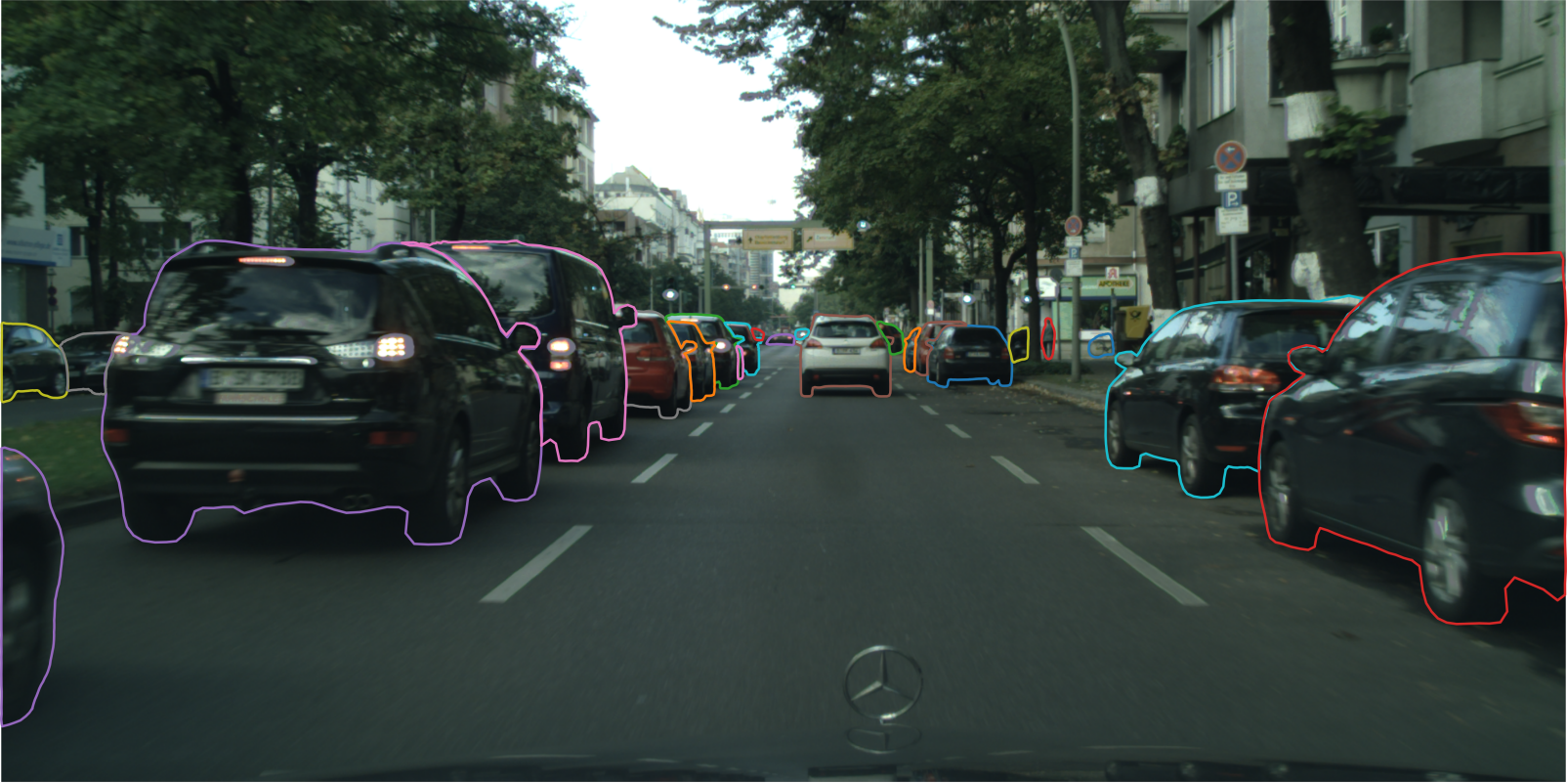E2EC: An End-to-End Contour-based Method for High-Quality High-Speed Instance Segmentation
Tao Zhang, Shiqing Wei, Shunping Ji
CVPR 2022
Any questions or discussions are welcomed!
Please see INSTALL.md.
We re-tested the speed on a single RTX3090.
| Dtataset | AP | Image size | FPS |
|---|---|---|---|
| SBD val | 59.2 | 512×512 | 59.60 |
| COCO test-dev | 33.8 | original size | 35.25 |
| KINS val | 34.0 | 768×2496 | 12.39 |
| Cityscapes val | 34.0 | 1216×2432 | 8.58 |
The accuracy and inference speed of the contours at different stages on SBD val set. We also re-tested the speed on a single RTX3090.
| stage | init | coarse | final | final-dml |
|---|---|---|---|---|
| AP | 51.4 | 55.9 | 58.8 | 59.2 |
| FPS | 101.73 | 91.35 | 67.48 | 59.6 |
The accuracy and inference speed of the contours at different stages on coco val set.
| stage | init | coarse | final | final-dml |
|---|---|---|---|---|
| AP | 27.8 | 31.6 | 33.5 | 33.6 |
| FPS | 80.97 | 72.81 | 42.55 | 35.25 |
-
Download the pretrained model here or Baiduyun(password is
e2ec). -
Prepared the COCO dataset according to the INSTALL.md.
-
Test:
# testing segmentation accuracy on coco val set python test.py coco --checkpoint /path/to/model_coco.pth --with_nms True # testing detection accuracy on coco val set python test.py coco --checkpoint /path/to/model_coco.pth --with_nms True --eval bbox # testing the speed python test.py coco --checkpoint /path/to/model_coco.pth --with_nms True --type speed # testing the contours of specified stage(init/coarse/final/final-dml) python test.py coco --checkpoint /path/to/model_coco.pth --with_nms True --stage coarse # testing on coco test-dev set, run and submit data/result/results.json python test.py coco --checkpoint /path/to/model_coco.pth --with_nms True --dataset coco_test
-
Download the pretrained model here or Baiduyun(password is
e2ec). -
Prepared the SBD dataset according to the INSTALL.md.
-
Test:
# testing segmentation accuracy on SBD python test.py sbd --checkpoint /path/to/model_sbd.pth # testing detection accuracy on SBD python test.py sbd --checkpoint /path/to/model_sbd.pth --eval bbox # testing the speed python test.py sbd --checkpoint /path/to/model_sbd.pth --type speed # testing the contours of specified stage(init/coarse/final/final-dml) python test.py sbd --checkpoint /path/to/model_sbd.pth --stage coarse
-
Download the pretrained model here or Baiduyun(password is
e2ec). -
Prepared the KINS dataset according to the INSTALL.md.
-
Test:
Maybe you will find some troules, such as
object of type <class 'numpy.float64'> cannot be safely interpreted as an integer. Please modify the/path/to/site-packages/pycocotools/cooceval.py. Replacenp.round((0.95 - .5) / .05)in lines 506 and 507 withint(np.round((0.95 - .5) / .05)).# testing segmentation accuracy on KINS python test.py kitti --checkpoint /path/to/model_kitti.pth # testing detection accuracy on KINS python test.py kitti --checkpoint /path/to/model_kitti.pth --eval bbox # testing the speed python test.py kitti --checkpoint /path/to/model_kitti.pth --type speed # testing the contours of specified stage(init/coarse/final/final-dml) python test.py kitti --checkpoint /path/to/model_kitti.pth --stage coarse
-
Download the pretrained model here or Baiduyun(password is
e2ec). -
Prepared the KINS dataset according to the INSTALL.md.
-
Test:
We will soon release the code for e2ec with multi component detection. Currently only supported for testing e2ec performance on cityscapes dataset.
# testing segmentation accuracy on Cityscapes with coco evaluator python test.py cityscapesCoco --checkpoint /path/to/model_cityscapes.pth # with cityscapes official evaluator python test.py cityscapes --checkpoint /path/to/model_cityscapes.pth # testing the detection accuracy python test.py cityscapesCoco \ --checkpoint /path/to/model_cityscapes.pth --eval bbox # testing the speed python test.py cityscapesCoco \ --checkpoint /path/to/model_cityscapes.pth --type speed # testing the contours of specified stage(init/coarse/final/final-dml) python test.py cityscapesCoco \ --checkpoint /path/to/model_cityscapes.pth --stage coarse # testing on test set, run and submit the result file python test.py cityscapes --checkpoint /path/to/model_cityscapes.pth \ --dataset cityscapes_test
-
Install the Boundary IOU API according boundary iou.
-
Testing segmentation accuracy with coco evaluator.
-
Using offline evaluation pipeline.
python /path/to/boundary_iou_api/tools/coco_instance_evaluation.py \ --gt-json-file /path/to/annotation_file.json \ --dt-json-file data/result/result.json \ --iou-type boundary
-
Download the pretrained model.
-
Visualize:
# inference and visualize the images with coco pretrained model python visualize.py coco /path/to/images \ --checkpoint /path/to/model_coco.pth --with_nms True # you can using other pretrained model, such as cityscapes python visualize.py cityscapesCoco /path/to/images \ --checkpoint /path/to/model_cityscapes.pth # if you want to save the visualisation, please specify --output_dir python visualize.py coco /path/to/images \ --checkpoint /path/to/model_coco.pth --with_nms True \ --output_dir /path/to/output_dir # visualize the results at different stage python visualize.py coco /path/to/images \ --checkpoint /path/to/model_coco.pth --with_nms True --stage coarse # you can reset the score threshold, default is 0.3 python visualize.py coco /path/to/images \ --checkpoint /path/to/model_coco.pth --with_nms True --ct_score 0.1 # if you want to filter some of the jaggedness caused by dml # please using post_process python visualize.py coco /path/to/images \ --checkpoint /path/to/model_coco.pth --with_nms True \ --with_post_process True
We have only released the code for single GPU training, multi GPU training with ddp will be released soon.
python train_net.py sbd --bs $batch_size
# if you do not want to use dinamic matching loss (significantly improves
# contour detail but introduces jaggedness), please set --dml as False
python train_net.py sbd --bs $batch_size --dml False
python train_net.py kitti --bs $batch_size
python train_net.py cityscapesCoco --bs $batch_size
In fact it is possible to achieve the same accuracy without training so many epochs.
# first to train with adam
python train_net.py coco --bs $batch_size
# then finetune with sgd
python train_net.py coco_finetune --bs $batch_size \
--type finetune --checkpoint data/model/139.pth
If the annotations is in coco style:
-
Add dataset information to
dataset/info.py. -
Modify the
configs/coco.py, reset thetrain.dataset,model.heads['ct_hm']andtest.dataset. Maybe you also need to change thetrain.epochs,train.optimizer['milestones']and so on. -
Train the network.
python train_net.py coco --bs $batch_size
If the annotations is not in coco style:
-
Prepare
dataset/train/your_dataset.pyanddataset/test/your_dataset.pyby referring todataset/train/base.pyanddataset/test/base.py. -
Prepare
evaluator/your_dataset/snake.pyby referring toevaluator/coco/snake.py. -
Prepare
configs/your_dataset.pyand by referring toconfigs/base.py. -
Train the network.
python train_net.py your_dataset --bs $batch_size
If you find this project helpful for your research, please consider citing using BibTeX below:
@article{zhang2022e2ec,
title={E2EC: An End-to-End Contour-based Method for High-Quality High-Speed Instance Segmentation},
author={Zhang, Tao and Wei, Shiqing and Ji, Shunping},
journal={arXiv preprint arXiv:2203.04074},
year={2022}
}
Code is largely based on Deep Snake. Thanks for their wonderful works.
